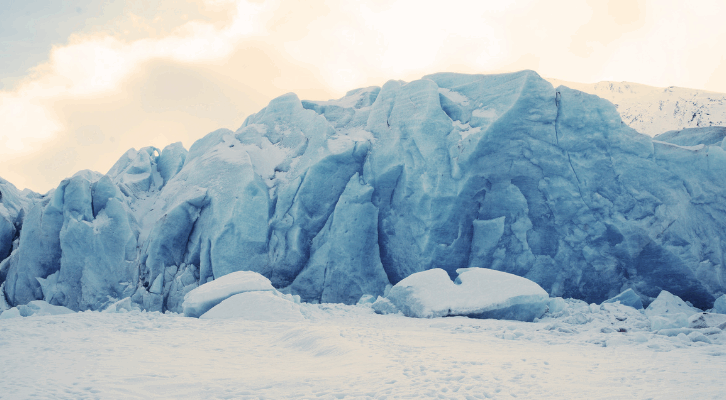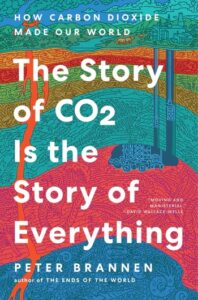
What Would Happen If All the Ice on Earth Suddenly Melted?
Peter Brannen on the Melting of Snowball Earth
Today CO2 sits at 421 parts per million (ppm), or 0.042 percent, far higher than it’s ever been in the history of Homo sapiens. In fact, it’s the highest it’s been since the Pliocene epoch over 3 million years ago, when evergreen forests stretched all the way to the shores of the Arctic Ocean, the Greenland and the West Antarctic ice sheets likely didn’t exist, and the shoreline of the United States pushed almost halfway into the Carolinas. A CO2 level over 400 ppm, like it is today, then, is very high in the context of our modern world. Even keeping our planet at a lower level of 350 ppm indefinitely would likely raise our seas, perhaps by as much as seventy feet in the next few centuries.
And in a worst-case climate scenario, humans could inject enough CO2 into the air to push that number over 1,000 ppm. This is a level not seen on this planet since there were crocodiles and palm trees in the Arctic Circle 50 million years ago—when there was no ice on Antarctica, and the tropics would have been totally unlivable for mammals like ourselves. With those numbers in mind, we now turn our attention to the outrageous end of the Snowball, 600 million years earlier.
When you cover the continents with mile-thick ice sheets like the Snowball did, and when you make it so cold and dry that you all but end the phenomenon of weather altogether, the CO2-burying processes of rock weathering shut down entirely. And if you cover the oceans in a callus of ice, so too does almost all photosynthesis. As a result, you all but stop pulling CO2 out of the air altogether. What never stops, though, is the eternal leak of CO2 from the necks of volcanoes poking above the frozen wastes.
Everything about this epoch is superlative, bizarre, unprecedented.
During the endless silence of planetary glaciation 700 million years ago, volcanic CO2 was all the while building and building in the air, billowing from ice-choked calderas that poked out of the mile-thick rime. But with the planet encased in ice, this CO2 wasn’t ever getting scrubbed from the atmosphere, so it just kept piling up and piling up in the sky for tens of millions of years. Budyko was right to think that getting out of Snowball Earth was almost impossible, but he didn’t account for just how bizarre and out of equilibrium this planetary state really was. When CO2 at last passed a certain threshold on Snowball Earth, perhaps as high as an unfathomable 100,000 ppm or more, the ice world disintegrated almost instantaneously—launching the planet instead into a phantasmagoric supergreenhouse inferno.
The Snowball was suddenly obliterated by unimaginably high heat and CO2, and the global ice sheets flooded the oceans with steaming meltwater. Sea level might have risen by a kilometer in just two thousand years. The ferocious melt was so rapid that it might have capped the oceans in a mile-deep lid of 130°F fresh water, one that still sat atop near-freezing, supersalty seas of the dearly departed Snowball. As the oceans began to mix, they rose an additional 150 feet just from the warming of the water alone.
Absurdly, though, if you were standing on a Rodinian beach you might not have even noticed the seas rising at all. This is because, as the land bounced back from underneath the weight of the now-vanished ice sheets, and the gravitational pull of these titanic ice sheets on the oceans disappeared, the seas might have appeared to some Rodinian beachgoers to instead retreat from the coast, and even drop by over three hundred feet—despite the unthinkable rise in sea level globally. But anyone unlucky enough to find themselves on the super-continent at the time would have had more pressing matters to attend to than their beachfront property’s resale value: the outlandish CO2 levels may have caused temperatures over land to soar more than 170°F. And when it was all over, one research group claims, the ice sheets had scraped a global average of three to five kilometers (about two to three miles) of rock off the surface of the entire planet. Everything about this epoch is superlative, bizarre, unprecedented.
“The late Neoproterozoic world was, quite literally, a different Earth.”
In the Mojave, under the shade of Joshua trees, a strange pale carbonate rock caps the glacial deposits. It’s the same strange rock that caps Snowball Earth deposits all over the world, and that is nearly unique in Earth history. Unlike the carbonates today that make up coral reefs, and that carpet the bottom of the ocean in seashells, life didn’t lay down this rock. It simply crashed out of the oversaturated seas, violently precipitating out of the ocean all on its own, without the help of life, directly onto the seafloor, all at once, in massive sheets.
In 1998, a team led by Harvard University geologists Paul Hoffman and Daniel Schrag held up these bizarre rocks as proof that Snowball Earth was terminated by an unimaginably high-CO2 supergreenhouse. On a world that was just ground to flour by ice sheets, and then torched by absurd levels of carbon dioxide, this was a rock-weathering fever dream. These carbon-rich rocks simply crystallized out of the ocean, conjured by some of the most extreme ocean chemistry in Earth history.
“There is a need for something catastrophic,” Oxford’s Raymond Pierrehumbert writes about these strange febrile strata, visible here in Death Valley and sitting right atop the glacial rocks of the Snowball itself. “Something with a switch that can cause an avalanche of carbonate into the ocean…There is no shortage of weirdness that needs to be accounted for.”
At this point the Earth’s carbon cycle and climate were completely unhinged, and within about 15 million years so much CO2 had been buried in this postglacial avalanche of carbon into the ocean—and by storms of resplendent green algae kindled by the flood of nutrients violently weathering out of Rodinia—that the Earth doubled back, and plummeted again into the complete and utter desolation of planetary glaciation. Snowball Earth, round two.
By this point you can guess what happened. During this encore of Snowball Earth, with the world imprisoned in ice once more, volcanic CO2 built back up in the atmosphere again, unchecked over millions of hopelessly cold years and eventually reaching outrageously high, nightmarish levels. Then the reverse apocalypse kicked in and the planet melted “overnight” in a high-CO2 inferno again—this time after being frozen for only 15 million years of utter planetary desolation. The bizarre carbonates from this post-Snowball Supergreenhouse once more drape glacial rocks all over the world, sometimes in avalanches of limestone cement hundreds of feet thick.
As the Snowball catastrophically collapsed once more, superhot oceans of meltwater, just offshore from rapidly disintegrating mile-thick ice sheets, drove some of the wildest weather in Earth history. Many of the strange postglacial rocks, some of which formed at the bottom of the ocean more than 1,000 feet deep, ominously bear the petrified ripple marks of gigantic waves that endlessly passed in the storm-tossed seas far overhead—the only signature known from the entire rock record on Earth of such extreme weather. “The late Neoproterozoic world was, quite literally, a different Earth,” writes Smithsonian Institution paleontologist Doug Erwin.
Before long, though, these strange creatures would give way at last to the high-energy acid trip of animal life.
Now for the weirdest part. Not only did the apocalyptic seesaw between the godforsaken wastelands of Snowball Earth and the chaotic, ultrahigh-CO2 supergreenhouse aftermaths not exterminate all life on Earth, but animal life seems to have been somehow forged by it. Near the end of the age of the Snowball, sunbaked rocks in Oman bear the whiff of a fossil steroid produced today only by sponges—the simplest and perhaps oldest lineage of animals. Jellyfish too likely sailed through these brave new seas. And in the tens of millions of years after Snowball Earth, the beginnings of a new planet became unmistakable.
After one final, halfhearted attempt at a Snowball 579 million years ago—an aborted glacial reconquest that barely escaped the poles—the fossil record of large complex life astonishingly arrives with a provisional world of mysterious blob creatures, clinging to peaceful seafloor gardens. There were fractal blobs, six-foot- long ribbed fronds, and various forms pressed into the rock that could be most faithfully described as “doodads.” Before long, though, these strange creatures would give way at last to the high-energy acid trip of animal life. Soon bizarre, three-foot-long “anomalocarids” darted through the seas like krill from hell, led by barbed arms that sprang straight from their faces. The creatures’ slatted flanks beat rhythmically as they chased trilobites across the seafloor.
Today these first monsters are imprisoned in the rocks, crumbling from mountainsides of scree in British Columbia, and paved over by suburban subdivisions in Pennsylvania. Bulbous worms, meanwhile, retreated from the Cambrian fever dream, and into the seafloor they burrowed, churning up muck that had been undisturbed for billions of years. As uncanny as these early creatures were, though, every single animal phylum alive on Earth today appeared in some form in this “explosion” of animal life in the Cambrian Period. Even our unimpressive ancestors, which appear as tiny flukelike fossil smudges in the rocks, and which bear the first tentative hints of a backbone, make a cameo here. Everything in Earth history to follow, then, is a variation on a theme—though there would be some rather elaborate variations, from T. rexes to blue whales.
At the end of almost 4 billion years, on a planet bereft of complex life, the Earth had been suddenly throttled by the most extreme convulsions of the carbon cycle in its entire history. It endured its most extreme climate catastrophes—the most extreme cold, the most extreme heat, the most extreme sea-level fall, the most extreme sea-level rise, the most extreme volcanoes, the most extreme erosion, the most extreme winds, the most extreme waves, the most extreme ocean chemistry, and the most extreme transformation in the planet’s entire history.
In Death Valley, this entire story is written in unassuming rocks—stromatolites, tillites, cap carbonates—whose drab textures are easily overlooked for the fireworks of desert flowers and collared lizards hosted on their surface, but that nevertheless signal a total planetary catastrophe almost 100 million years long. It was a complete destabilization of the Earth system, and it was one driven by carbon dioxide. All hell broke loose, and when it ended—for some reason—the riot of animal life exploded.
__________________________________

From The Story of CO2 Is the Story of Everything by Peter Brannen. Copyright © 2025 by Peter Brannen. Excerpted by permission of Ecco, an imprint of HarperCollins Publishers.
Peter Brannen
Peter Brannen is a contributing writer at The Atlantic. He is the author of The Ends of the World, about the biggest mass extinctions in Earth’s history. His work has also appeared in the New York Times, the Washington Post, and other publications.



















